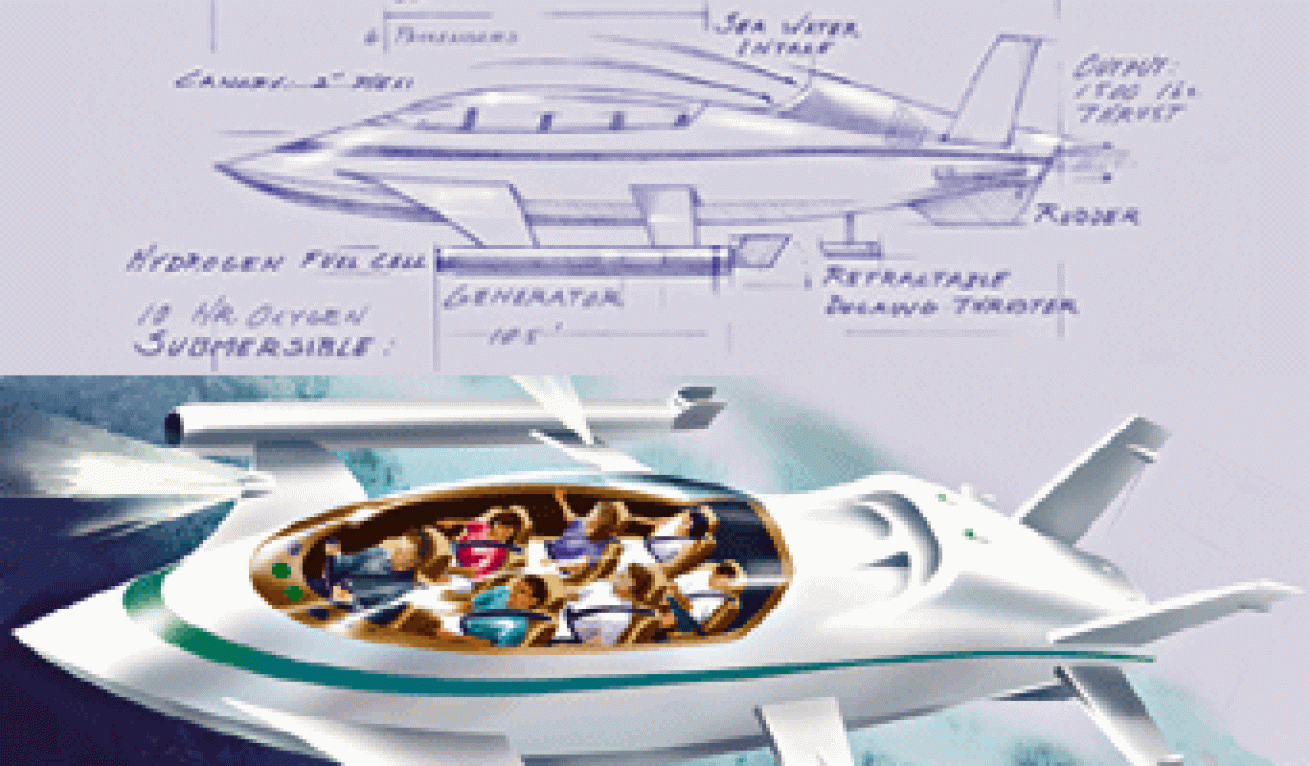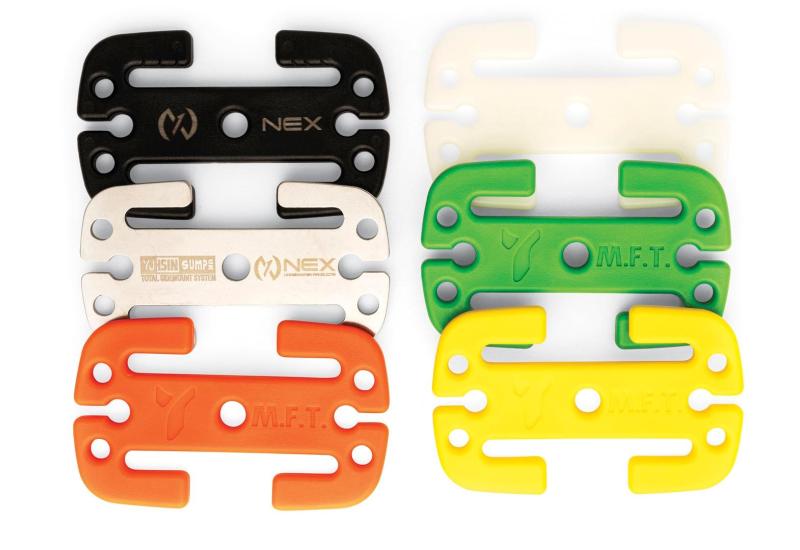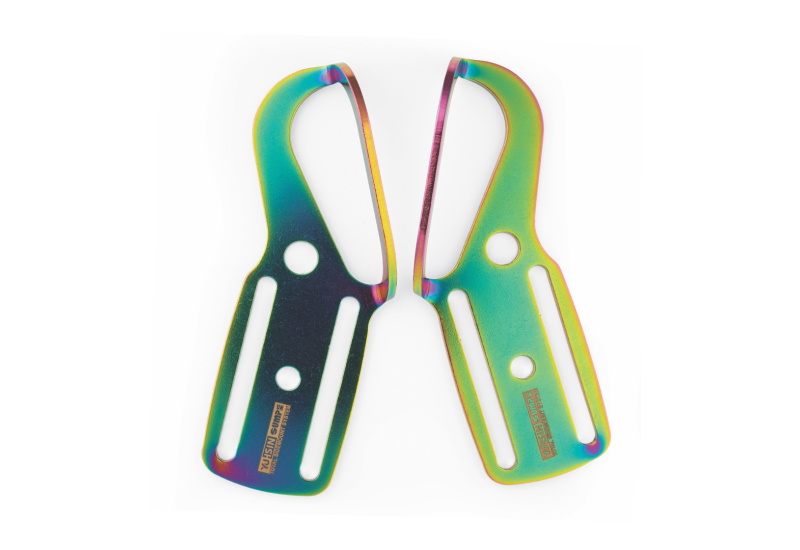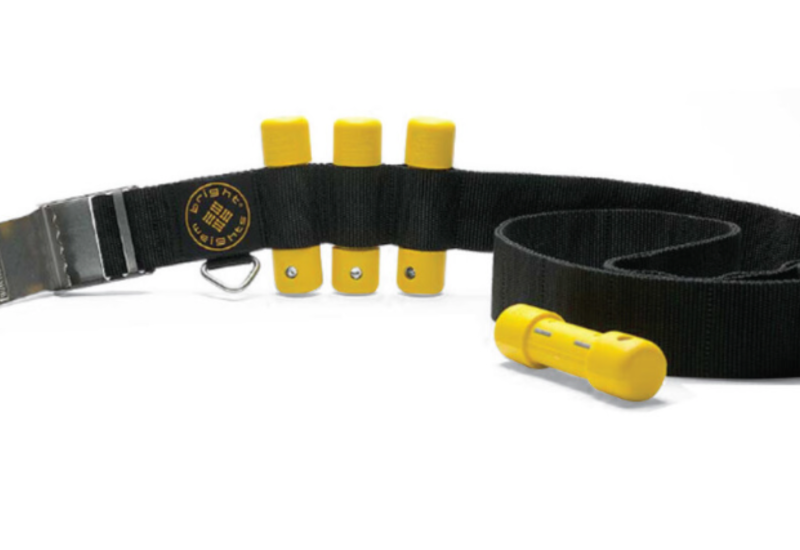Future Gear

Illustration by John Francis
By Rich Barlow
The biggest problem with scuba diving today? Same as it ever was: We are unwebbed, unfinned, air-gulping terrestrials making our way in an alien world. Scuba gear has come a long way in the last 50 years, but will go even further in the next 50.
To find out how scuba gear will change in the future, we asked divers, equipment makers and scientists to untether their imaginations and gaze into their crystal balls. When astronauts are piloting the vastness of outer space, what will our descendants be doing in inner space? A mosaic of our visionaries' views suggests they will converse under water as crisply as William F. Buckley, swallow pills enriched with "nanobots" to ward off the bends and safely sidestep tour subs with the aid of rockets on their legs. And they may be breathing through their pants.
Breathing
To borrow from A Cole Porter song, in shallow shoals English soles do it; goldfish in the privacy of bowls do it. Why can't we devise a way to breathe as easily under water as on land? Some people speculate that genetic fiddling might breed gill-men one day. But why blunder into that ethical swamp when it's possible to make easily portable artificial gills?
In the 1970s, researchers at Duke University toyed with a "hemosponge," laced with an extract from fish blood that could absorb oxygen from water and store it for a diver to breathe. They never perfected the device, but for dreamers, they pointed the way.
"If I had $10 million, I would probably come up in three or four years with a working prototype" of an artificial gill, says engineering professor Victor Petrenko of Dartmouth College's Thayer School, who envisions a T-shirt made from oxygen-absorbing synthetics. "You could dive if you want to for a week instead of an hour, if you like it down there. You could sleep there," says Petrenko, whose fashion sense is as expansive as his vision: Those gills could be in your swimming trunks. T-shirt or trunks, a hose connected to the gill and running to your mouth would allow you to breathe.

As for short-term improvement to regulators, the possibilities seem exhausted: "We have almost reached a plateau with what we can do in terms of mechanical design" of regulators, says Aqua Lung's marketing manager, Robbert Bruins. It's unclear how much improvement could be wrung from electronic or digital regulators, which would monitor the diver's breathing and trigger gas flow when needed, according to John Clarke, scientific director at the Navy's Experimental Diving Unit. Nevertheless, Bruins says that manufacturers jousting for marketing advantages could bring out some form of electronic regulator within a decade.
The near future may have less to do with putting people under water than with putting robots there. David Mindell, who makes his living doing that as head of MIT's Deep Water Archaeology Research Group, says that within 10 years, we may get free-swimming robots, "automated buddies" that could do everything from toting extra air to filming your dive for you.
Communication
Under water "has always been the world of silence" for human communications, says Sergio Gamberini of Ocean Reef Group. But gear makers like his are striving to inject a little chatter via underwater voice comm systems. Pioneering analog products cost thousands of dollars and are susceptible to distortion and noise interference. "Think of standing on the edge of the Grand Canyon and trying to talk to somebody on the other side," says Jim Preisig, a scientist with the Woods Hole Oceanographic Institution. Echoes distort your voice, and the same happens under water as sound bounces off the bottom and off the constantly moving water surface.
In 15 years, however, digital communications--breaking the human voice into bits of ones and zeros, transmitting the bits using a signal and reassembling them as a voice to the listener, in the same way digital wireless phones do--should allow divers a kilometer apart to chat away as easily as Oprah and Dr. Phil, Preisig forecasts. The ones and zeros would be converted into sound that would travel through the water to a receiver in the other diver's mask. After weeding out echoes and background noise, the receiver would decipher the ones and zeros and convert the sound back into electric signals that the other diver would hear as your voice.
For divers with advanced skills but average budgets, the equipment may be prohibitively expensive. But "for people who can afford the equipment, it will be standard operating procedure," says Preisig.
What about keeping in touch with shore? This is the 21st century, and everyone has a cell phone. Divers will be no different, says Gamberini, who predicts there will be land equipment in which divers will install personal computer-chip cards that will tie them into cellular networks. "It will be possible by a wrist keyboard to dial the numbers and receive a phone call," he says.
Exposure Suits

What will the future bring for wetsuits? Don't throw away your neoprene just yet. Navy testing of an "amphibian skin," a thin, flexible membrane that breathes through pores, retaining heat when the diver needs it and releasing it without the diver having to undress, has been less than inspiring. But we may be better insulated in the future, thanks to our underwear.
Diving Unlimited International sold 10 electric underwear systems last year to technical divers, to be worn under dry suits. A Lycra liner with five pads, attached to the calves, forearms and lower back, holds a computer chip in the chest that reads the pads' temperature. When the diver expends energy, the pads stay cool. "But when you're sitting still, or they feel the temperature of your skin drop, they turn on," says DUI President Susan Long.
For now, prototype underwear for recreational divers is too bulky, mostly because the computer chip is in a block the size of two cigarette boxes. Long predicts it will become mainstream diveware in a few years, once that problem and another, providing an ample power source to free-swimming divers, are solved.
Masks
The exception to the rule that, in gear, smaller is better. They've gone about as far as they could go with vision correction, more windows, rounded windows, purge valves, etc. And since light rays need to mix with air in front of your eye in order for you to focus under water, going smaller (replacing a mask with contact lenses, say) isn't feasible. In fact, as masks morph into the nerve center of a diver's communication system, they'll bulk up.
What really sets tech-lovers' heartbeats aflutter is the prospect of heads-up display, a virtual readout from your dive computer thrown into your mask. San Leandro, Calif., based Oceanic announced last year that it was manufacturing a HUD for the Navy. The company is mum about when a civilian version might hit dive store shelves.
Navigation
Some laws of the universe are unchangeable. Howard Stern will never host a show on NPR, and the Global Positioning System, great on land, will never work under water, says Jim Preisig, because electromagnetic signals don't penetrate salt water very well. Instead, the future belongs to acoustics.
In perhaps five years, some genius will whip up "electronic breadcrumbs," acoustic devices that a diver could scatter at spots within a diving area, says MIT's Mindell. The diver would bounce a signal off of the markers to fix her location. Acoustic systems available now run to the thousands of dollars, but Preisig knows these things change. As a Coast Guardsman 20 years ago, he helped evaluate the newfangled GPS. His conclusion: "There would never be GPS units that were cheap enough for civilians to use." Today, when drivers pass him in their satellite-steered sedans, Preisig remembers: "Never say never."
Buoyancy
Eliot Grigg, a colleague of Petrenko's at Dartmouth, recently gave his students an exam question: How could the Navy engineer better swimmers by, in effect, turning people into fish? Among the problems the students pondered was improving human buoyancy. Unlike fish, we don't have a swim bladder that is inflated with gas levels automatically adjusted by the nervous system, depending on depth. And there's not much room in the compact human body to put a swim bladder, says Grigg. But there's another way: a BC that would adjust automatically to maintain neutral buoyancy. An automatic BC would use a sensor that measured changes in the water pressure on the diver, just as autopilots on planes detect changes in air pressure, says the Navy's John Clarke. The BC would add or subtract gas as the pressure changed to maintain neutral buoyancy. Any diver who has tried to brake a too-rapid ascent and yo-yoed in the water as he's fumbled to adjust his buoyancy will appreciate the convenience of automation.
The industry has prototypes, but has stumbled over obstacles like the humble "off'' switch. You'd need a reliable override control so you could swim up over that coral and then back down again.
Decompression

Nanotechnology--the building of microscopically tiny substances--may lick the diver's nemesis, decompression sickness. The field's Manhattan Project is the so-called universal assembler, a robot no bigger than a DNA strand that could manipulate billions of atoms one by one, plucking them off of molecular structures and sculpting them into something else with the finesse of Rodin. "Within 50 years, we'll probably have it," says Grigg. If that happens, we really will be in a brave new world. The writer Bill Mc-Kibben theorizes that an assembler might go to work on a pile of grass and change it into beef.
What would all this mean for divers? An assembler might be used to configure a pill that would neutralize nitrogen in the bloodstream. Nanobots in the pill would bond to the nitrogen and prevent it from forming bubbles, rendering it a harmless compound to be excreted, says Grigg. And when nitrogen is taken out of the equation, the rules of decompression as we know them go out the window. Are you ready for some serious bottom time?
Dive Computers
Manufacturers have already squeezed dive computers into watches. And they'll get smaller still, in inverse proportion to their storage capacity. Gianni Garofalo of Mares, who has helped refine equipment during four decades of diving, predicts that, in the future, divers will be toting around the equivalent of cyber-warehouses that will not only give them dive data but could hold message transmitters, lighting and directional finders--everything but pour a cup of coffee for you. And they'll be integrated into other equipment. "It's going to be in the masks and it's going to be in the gloves and it's going to be in the tanks," predicts Grigg.
Fins
The graveyard of bright ideas. "Split fins were really the first real innovation in fins that I have seen" in 30-plus years, says Doug Toth of Atomic Aquatics. Further fin-ovation is hard to pull off. Webbed feet? Not very efficient unless human toes get longer to accommodate sufficient webbing, says Grigg. Small propellants attached to the feet or tanks? Mazin Submersible Technology has Jetboots, leg-mounted rockets that promise up to 40 pounds of thrust. But at around $3,500, they're pretty pricey per pound. Still, Garofalo thinks this genre could take off, pardon the pun, with the invention some day of tiny, powerful batteries for power.
Which brings us to the ultimate wet dream--
Transportation
We couldn't close without a nod to the big thinkers who foresee the day when diving won't be left to only divers. Humanity and the sea are braided together in a common destiny of ever-increasing contact, they say, to the point where even couch potatoes who'd never don a wetsuit will be able to view the wonders of the deep. "The advance, when it will come, will be when you can climb in your little robotic vehicle and just buzz off down to 10,000 feet," says Clive Cussler, the bestselling author of sea adventures who first put a tank on his back to go diving in 1951.
Nor do the big thinkers confine themselves to just writing about the future. Engineer and explorer Graham Hawkes tries to summon it in his day job, designing the Deep Flight and Deep Aviator submersibles that zip around under water more like planes than subs. Hawkes says inventing underwater "flight" is the first step toward the day when dive clubs, universities and others will own small, winged craft to chauffeur anyone who wants to get around the seas.
"There are going to be a lot more ways to go down and see it and enjoy it," he promises. "Divers won't have that all to themselves. There'll be an armchair way to enjoy" the ocean. For those who worry that human exploitation is a bad thing, Hawkes says the ocean will be like the Grand Canyon. Vegas lounge lizards can see it from a helicopter, while the macho hikers among us can still penetrate its wilderness on foot. So with the earth's waters: Plenty of room for everyone down there.
Democratizing the ocean or despoiling it? That's one for pundits, not prognosticators.

Illustration by John Francis
By Rich Barlow
The biggest problem with scuba diving today? Same as it ever was: We are unwebbed, unfinned, air-gulping terrestrials making our way in an alien world. Scuba gear has come a long way in the last 50 years, but will go even further in the next 50.
To find out how scuba gear will change in the future, we asked divers, equipment makers and scientists to untether their imaginations and gaze into their crystal balls. When astronauts are piloting the vastness of outer space, what will our descendants be doing in inner space? A mosaic of our visionaries' views suggests they will converse under water as crisply as William F. Buckley, swallow pills enriched with "nanobots" to ward off the bends and safely sidestep tour subs with the aid of rockets on their legs. And they may be breathing through their pants.
Breathing
To borrow from A Cole Porter song, in shallow shoals English soles do it; goldfish in the privacy of bowls do it. Why can't we devise a way to breathe as easily under water as on land? Some people speculate that genetic fiddling might breed gill-men one day. But why blunder into that ethical swamp when it's possible to make easily portable artificial gills?
In the 1970s, researchers at Duke University toyed with a "hemosponge," laced with an extract from fish blood that could absorb oxygen from water and store it for a diver to breathe. They never perfected the device, but for dreamers, they pointed the way.
"If I had $10 million, I would probably come up in three or four years with a working prototype" of an artificial gill, says engineering professor Victor Petrenko of Dartmouth College's Thayer School, who envisions a T-shirt made from oxygen-absorbing synthetics. "You could dive if you want to for a week instead of an hour, if you like it down there. You could sleep there," says Petrenko, whose fashion sense is as expansive as his vision: Those gills could be in your swimming trunks. T-shirt or trunks, a hose connected to the gill and running to your mouth would allow you to breathe.

As for short-term improvement to regulators, the possibilities seem exhausted: "We have almost reached a plateau with what we can do in terms of mechanical design" of regulators, says Aqua Lung's marketing manager, Robbert Bruins. It's unclear how much improvement could be wrung from electronic or digital regulators, which would monitor the diver's breathing and trigger gas flow when needed, according to John Clarke, scientific director at the Navy's Experimental Diving Unit. Nevertheless, Bruins says that manufacturers jousting for marketing advantages could bring out some form of electronic regulator within a decade.
The near future may have less to do with putting people under water than with putting robots there. David Mindell, who makes his living doing that as head of MIT's Deep Water Archaeology Research Group, says that within 10 years, we may get free-swimming robots, "automated buddies" that could do everything from toting extra air to filming your dive for you.
Communication
Under water "has always been the world of silence" for human communications, says Sergio Gamberini of Ocean Reef Group. But gear makers like his are striving to inject a little chatter via underwater voice comm systems. Pioneering analog products cost thousands of dollars and are susceptible to distortion and noise interference. "Think of standing on the edge of the Grand Canyon and trying to talk to somebody on the other side," says Jim Preisig, a scientist with the Woods Hole Oceanographic Institution. Echoes distort your voice, and the same happens under water as sound bounces off the bottom and off the constantly moving water surface.
In 15 years, however, digital communications--breaking the human voice into bits of ones and zeros, transmitting the bits using a signal and reassembling them as a voice to the listener, in the same way digital wireless phones do--should allow divers a kilometer apart to chat away as easily as Oprah and Dr. Phil, Preisig forecasts. The ones and zeros would be converted into sound that would travel through the water to a receiver in the other diver's mask. After weeding out echoes and background noise, the receiver would decipher the ones and zeros and convert the sound back into electric signals that the other diver would hear as your voice.
For divers with advanced skills but average budgets, the equipment may be prohibitively expensive. But "for people who can afford the equipment, it will be standard operating procedure," says Preisig.
What about keeping in touch with shore? This is the 21st century, and everyone has a cell phone. Divers will be no different, says Gamberini, who predicts there will be land equipment in which divers will install personal computer-chip cards that will tie them into cellular networks. "It will be possible by a wrist keyboard to dial the numbers and receive a phone call," he says.
Exposure Suits

What will the future bring for wetsuits? Don't throw away your neoprene just yet. Navy testing of an "amphibian skin," a thin, flexible membrane that breathes through pores, retaining heat when the diver needs it and releasing it without the diver having to undress, has been less than inspiring. But we may be better insulated in the future, thanks to our underwear.
Diving Unlimited International sold 10 electric underwear systems last year to technical divers, to be worn under dry suits. A Lycra liner with five pads, attached to the calves, forearms and lower back, holds a computer chip in the chest that reads the pads' temperature. When the diver expends energy, the pads stay cool. "But when you're sitting still, or they feel the temperature of your skin drop, they turn on," says DUI President Susan Long.
For now, prototype underwear for recreational divers is too bulky, mostly because the computer chip is in a block the size of two cigarette boxes. Long predicts it will become mainstream diveware in a few years, once that problem and another, providing an ample power source to free-swimming divers, are solved.
Masks
The exception to the rule that, in gear, smaller is better. They've gone about as far as they could go with vision correction, more windows, rounded windows, purge valves, etc. And since light rays need to mix with air in front of your eye in order for you to focus under water, going smaller (replacing a mask with contact lenses, say) isn't feasible. In fact, as masks morph into the nerve center of a diver's communication system, they'll bulk up.
What really sets tech-lovers' heartbeats aflutter is the prospect of heads-up display, a virtual readout from your dive computer thrown into your mask. San Leandro, Calif., based Oceanic announced last year that it was manufacturing a HUD for the Navy. The company is mum about when a civilian version might hit dive store shelves.
Navigation
Some laws of the universe are unchangeable. Howard Stern will never host a show on NPR, and the Global Positioning System, great on land, will never work under water, says Jim Preisig, because electromagnetic signals don't penetrate salt water very well. Instead, the future belongs to acoustics.
In perhaps five years, some genius will whip up "electronic breadcrumbs," acoustic devices that a diver could scatter at spots within a diving area, says MIT's Mindell. The diver would bounce a signal off of the markers to fix her location. Acoustic systems available now run to the thousands of dollars, but Preisig knows these things change. As a Coast Guardsman 20 years ago, he helped evaluate the newfangled GPS. His conclusion: "There would never be GPS units that were cheap enough for civilians to use." Today, when drivers pass him in their satellite-steered sedans, Preisig remembers: "Never say never."
Buoyancy
Eliot Grigg, a colleague of Petrenko's at Dartmouth, recently gave his students an exam question: How could the Navy engineer better swimmers by, in effect, turning people into fish? Among the problems the students pondered was improving human buoyancy. Unlike fish, we don't have a swim bladder that is inflated with gas levels automatically adjusted by the nervous system, depending on depth. And there's not much room in the compact human body to put a swim bladder, says Grigg. But there's another way: a BC that would adjust automatically to maintain neutral buoyancy. An automatic BC would use a sensor that measured changes in the water pressure on the diver, just as autopilots on planes detect changes in air pressure, says the Navy's John Clarke. The BC would add or subtract gas as the pressure changed to maintain neutral buoyancy. Any diver who has tried to brake a too-rapid ascent and yo-yoed in the water as he's fumbled to adjust his buoyancy will appreciate the convenience of automation.
The industry has prototypes, but has stumbled over obstacles like the humble "off'' switch. You'd need a reliable override control so you could swim up over that coral and then back down again.
Decompression

Nanotechnology--the building of microscopically tiny substances--may lick the diver's nemesis, decompression sickness. The field's Manhattan Project is the so-called universal assembler, a robot no bigger than a DNA strand that could manipulate billions of atoms one by one, plucking them off of molecular structures and sculpting them into something else with the finesse of Rodin. "Within 50 years, we'll probably have it," says Grigg. If that happens, we really will be in a brave new world. The writer Bill Mc-Kibben theorizes that an assembler might go to work on a pile of grass and change it into beef.
What would all this mean for divers? An assembler might be used to configure a pill that would neutralize nitrogen in the bloodstream. Nanobots in the pill would bond to the nitrogen and prevent it from forming bubbles, rendering it a harmless compound to be excreted, says Grigg. And when nitrogen is taken out of the equation, the rules of decompression as we know them go out the window. Are you ready for some serious bottom time?
Dive Computers
Manufacturers have already squeezed dive computers into watches. And they'll get smaller still, in inverse proportion to their storage capacity. Gianni Garofalo of Mares, who has helped refine equipment during four decades of diving, predicts that, in the future, divers will be toting around the equivalent of cyber-warehouses that will not only give them dive data but could hold message transmitters, lighting and directional finders--everything but pour a cup of coffee for you. And they'll be integrated into other equipment. "It's going to be in the masks and it's going to be in the gloves and it's going to be in the tanks," predicts Grigg.
Fins
The graveyard of bright ideas. "Split fins were really the first real innovation in fins that I have seen" in 30-plus years, says Doug Toth of Atomic Aquatics. Further fin-ovation is hard to pull off. Webbed feet? Not very efficient unless human toes get longer to accommodate sufficient webbing, says Grigg. Small propellants attached to the feet or tanks? Mazin Submersible Technology has Jetboots, leg-mounted rockets that promise up to 40 pounds of thrust. But at around $3,500, they're pretty pricey per pound. Still, Garofalo thinks this genre could take off, pardon the pun, with the invention some day of tiny, powerful batteries for power.
Which brings us to the ultimate wet dream--
Transportation
We couldn't close without a nod to the big thinkers who foresee the day when diving won't be left to only divers. Humanity and the sea are braided together in a common destiny of ever-increasing contact, they say, to the point where even couch potatoes who'd never don a wetsuit will be able to view the wonders of the deep. "The advance, when it will come, will be when you can climb in your little robotic vehicle and just buzz off down to 10,000 feet," says Clive Cussler, the bestselling author of sea adventures who first put a tank on his back to go diving in 1951.
Nor do the big thinkers confine themselves to just writing about the future. Engineer and explorer Graham Hawkes tries to summon it in his day job, designing the Deep Flight and Deep Aviator submersibles that zip around under water more like planes than subs. Hawkes says inventing underwater "flight" is the first step toward the day when dive clubs, universities and others will own small, winged craft to chauffeur anyone who wants to get around the seas.
"There are going to be a lot more ways to go down and see it and enjoy it," he promises. "Divers won't have that all to themselves. There'll be an armchair way to enjoy" the ocean. For those who worry that human exploitation is a bad thing, Hawkes says the ocean will be like the Grand Canyon. Vegas lounge lizards can see it from a helicopter, while the macho hikers among us can still penetrate its wilderness on foot. So with the earth's waters: Plenty of room for everyone down there.
Democratizing the ocean or despoiling it? That's one for pundits, not prognosticators.










